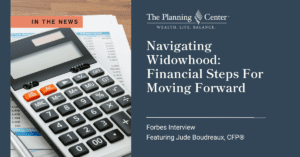
This is a guest blog post from Putting Money in the Context of Life™, a publication by Money Quotient®, designed for financial professionals who want to communicate a life-centered approach.
In a recent editorial for the National Endowment for Financial Education (NEFE), Brent Neiser commented on “Financial Stacking: A Modern American Burden.” He wrote:
“Myriad choices, opportunities, and expectations generated by the financial services industry, media, advertisements, experts, employers – and even family and friends – create an amassment of jumbled priorities that often leads to inaction, frustration, and despair.”
In short, your “financial stack” is made up of whatever financial issues take up your mind space. However, as Neiser points out, not everything in your financial stack has to be negative: “Even financial opportunities can add weight if you don’t feel empowered or prepared to take advantage of them.” The result is a vicious cycle because the growing emotional burden fuels stress, discouragement, and analysis paralysis.
Finding your Financial Mojo
What could possibly be the cure for this modern day malady? The antidote, it seems, is to focus first on evaluating and developing your sense of self-efficacy. This term was first introduced by psychologist Albert Bandura who spent his long career at Stanford University studying human motivation and behavioral change. He defined self-efficacy as a person’s belief in his/her ability to succeed in specific endeavors.
In fact, Bandura’s research demonstrated that self-efficacy is the most powerful determinant of an individual’s thoughts, feelings, behaviors, and accomplishments. He found that people with a strong sense of their capabilities 1) view difficult tasks as challenges to be mastered, 2) develop a deep interest in their activities, 3) set challenging goals and maintain a strong commitment to them, and 4) recover quickly from setbacks and disappointments.
In contrast, individuals with a weak sense of their capabilities 1) view difficult tasks as threats to be avoided, 2) quickly lose confidence and dwell on personal deficiencies and other obstacles to achieving desired results, 3) have low aspirations and weak commitment to goals, and 4) recover slowly from setbacks and disappointments.
Linking Self-Efficacy to Financial Well-Being
Because self-efficacy has been shown to be a powerful catalyst for positive change, a number of researchers and educators have been exploring the connection between this psychological precept and higher levels of financial well-being. In fact, one researcher concluded that financial self-efficacy appears to be the missing link between knowledge and effective action.
According to Bandura, there are four major sources of self-efficacy: experiencing success, choosing good role models, responding to encouragement, and managing physical and emotional responses. Therefore, because self-efficacy is task specific, it is important to consider how these four strategies can be applied to personal finance and utilized to nurture and strengthen a sense of financial self-efficacy.
Experiencing Success –
The most effective way to build a strong sense of self-efficacy is through performing a task successfully. One example from the world of personal finance is creating a plan to reduce spending and pay off a large credit card balance. The skills needed to manage cash flow and the discipline required to stick with the plan will inspire pride in accomplishment and motivate additional action steps toward financial well-being. In other words, successfully completing one important financial task will increase confidence in one’s ability to tackle the next one!
Choosing Role Models –
Witnessing friends and family members successfully completing a money management task is another important source of financial self-efficacy. According to Bandura, “Through their behavior and expressed ways of thinking, competent models transmit knowledge and teach observers effective skills and strategies for managing environmental demands.” For example, if a respected friend talks about how he/she researched several auto insurance policies before making a purchase, this would likely influence others in his/her social circle to do the same type of thoughtful and effective comparison shopping.
Responding to Encouragement –
Bandura also asserted that people can be persuaded to believe that they have the skills and capabilities needed to succeed. Therefore hearing and accepting encouragement from others will help individuals to conquer self-doubt and to focus instead on giving their best effort to overcoming financial challenges and achieving their financial goals.
Managing Physical & Emotional Response –
Moods, emotional states, physical reactions, and stress levels can all impact how a person feels about their abilities in a particular situation. By learning how to minimize stress and elevate mood when facing difficult or challenging tasks, people can improve their sense of self-efficacy.
As an illustration, paying monthly bills can be an anxiety producing activity for couples that can create tension and touch off arguments regarding each other’s spending habits. However, mutually defining and committing to ground rules for financial conversations will help to facilitate respectful and productive communication, and lay the groundwork for creating shared financial and life goals.
In conclusion…
As you create a plan to conquer your own financial stack, it is important to understand that your level of financial self-efficacy is not only influenced by your level of financial knowledge and skills. A number of studies have demonstrated that several subjective factors have a powerful influence on your sense of financial well-being and your motivation to make positive change.
Putting Money in the Context of Life™ is published four times a year by Money Quotient®, a non-profit organization focused on education and research. Putting Money in the Context of Life™is intended to provide readers with information to promote new perspectives on financial well-being, life planning, and retirement preparation. Each issue features inspirational and educational articles that explore life transitions and guide individuals in aligning their financial decisions with their values and priorities in all areas of life.






